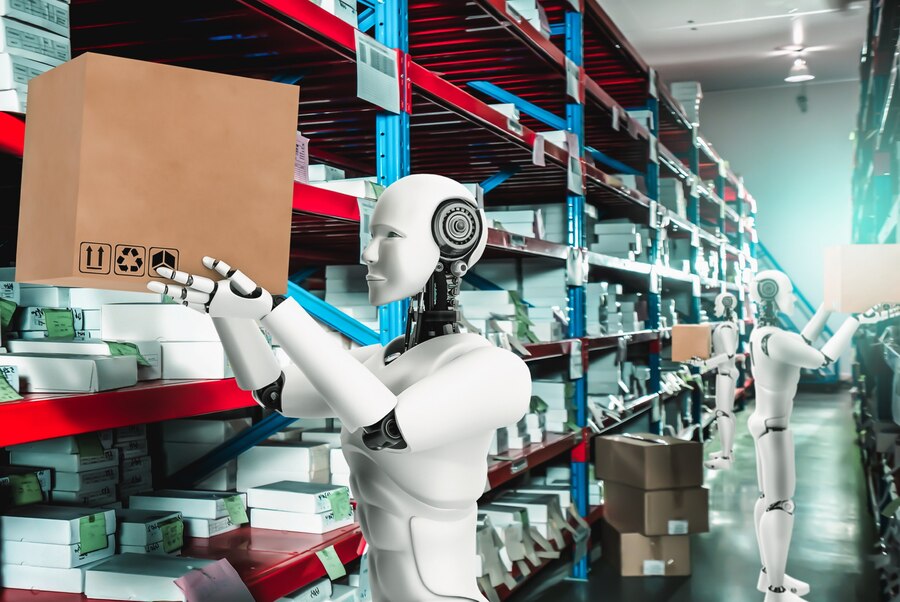
Types Of Robots Used In Automating Warehouses
Data shows that 20% of warehouses use robotics. The need for automation in robotics is inevitable because it addresses several challenges, like labour shortages. By optimizing automation, warehouses can substantially reduce mistakes, increase customer satisfaction, and establish a reputation for effectiveness and innovation. The types of robots used have also evolved. Today, shelf robots, co-bots, drones, and many more can be seen in warehouses.
Here is a sneak peek into some of the robots types:
- Goods-to-person robot
Goods-to-person robots traverse the warehouse, accessing items from storage areas and transporting them directly to human operators or assigned packing stations. This reduces the need for humans to travel around the aisles, increasing efficiency and productivity and reducing costs for the warehouse.
A goods-to-person robot can be integrated with other robotic systems, like a shelf robot or a takeaway conveyor. Additionally, you can choose from the different types of goods to person robots available. Grid-based uses a grid layout to house items, allowing robots to transport entire racks or pallets to pick stations.
Shuttles swiftly retrieve totes and excel in high-throughput environments with limited SKU counts. Robotic goods-to-person (G2P) systems rely on fixed racking for structured storage, which is ideal for large SKU counts. Carousel-based systems utilize rotating shelves for batch picking and are cost-effective for operations with lower throughput and SKU counts.
- Automated mobile robot
An autonomous mobile robot (AMR) is a robotic system capable of comprehending and navigating its surroundings without external assistance. Unlike earlier versions, such as autonomous guided vehicles (AGVs), which depend on tracks or predetermined routes and typically need supervision from operators, AMRs operate independently. The technology used in these robots is quite sophisticated.
Equipped with cameras and sensors, AMRs employ navigation techniques like collision avoidance when encountering unexpected obstacles such as fallen boxes or crowds. This allows them to adjust their speed, halt, or find alternative routes to circumvent the barriers before resuming their tasks.
- Palletizing robots
Palletizing robots stack products on pallets for storage and transport purposes. They work via hardware and software components to perform their tasks impeccably. The chief mechanism used to manipulate items is the robotic arm, which has grippers or end-of-arm tools.
By providing real-time feedback to the robot, advanced sensors and cameras help detect and locate objects with precision. The palletizing shelf robot enhances efficiency by large volumes.
- Packing and picking robots
These are programmable robotic arms designed for collecting and assembling orders for shipment. These sophisticated robots possess sensors, grippers, and algorithms that allow them to handle items of different shapes and sizes to deliver orders.
By utilizing picking and packing robots, businesses can significantly increase warehouse productivity. They can process sets of continuous orders nonstop without human intervention. Besides, owing to their quicker speeds, picking robots can fulfil orders faster than humans.
- Co-bots
Co-bots work along with humans in a warehouse. These kinds of robots perform slower functions owing to safety reasons. The sensors used are highly sophisticated, so the robots are well aware of their surroundings.
Co-bots, or collaborative robots, are designed to perform various functions. Their adaptability enables groups to quickly reconfigure them to conform to changes in priorities that arise when co-bots handle an array of smaller tasks.
The Future Of Robots In Warehousing
Robots are already used for a multitude of functions in warehouses. While a picking robot helps in picking items and placing them at their destined locations, a shelf robot helps in moving shelves or bins within a warehouse environment.
Robots are poised to become the focal point of industrial operations. Projections indicate that by 2025, approximately 50,000 warehouses will be equipped with robotics, boasting over four million robot installations
In addition to the different types of robots mentioned above, drones are also used excessively. They offer affordability, agility, and accessibility, capable of reaching any area within a warehouse. Drones prove valuable in inventory management, complementing barcode technology and supporting shipping and delivery tasks alongside human workers.
Prime Robotics – Abode Of New-Age Robots
You will be using cutting-edge robots for your warehouse at Prime Robotics. Prime Robotics provides a range of industry-leading robots emphasizing efficiency, dependability, and durability, such as Automated Storage and Retrieval Systems (AS/RS), Dynamic Pick Arms, and Autonomous Mobile Robots (AMRs).
By leveraging Prime Robotics’ suite of robots and software solutions, businesses can optimize their warehouse operations and realize significant returns on investment (ROI) while streamlining their processes. Get in touch today!



